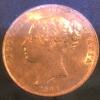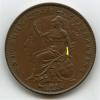I wanted to pick your collective brains on the “onc tenth” florins of 1853-1860, and possible theories on how the error came about.
1. Is it a “c” or an “e” with the oblique bar missing? A comparison of the “e” and “c” on the obverse seems to show a slight difference in the width of the letters.
2. If it’s an “e” with the bar missing, is this due to die fill? The oblique bar is very fine, so this could be a possible explanation. But if so, why does it only affect the “e” in “one” and not that in “tenth” (or the “e” in “One florin”, for that matter)?
3. Whether it’s a “c” or an “e” with a missing bar, could it be that a wrong or faulty puncheon was chosen when sinking the die? But again, why only the “e” in “one”?
4. Is it possible that there were puncheons for the entire word “one”, one of them was faulty, and that this was occasionally used over the course of 7 years when sinking new reverse dies? Each pair of dies produced only around 25,000 coins at the time, so the 1853 florin alone (mintage nearly 4 million) would have required upwards of 150 dies.
5. If 4 is the correct explanation, it could also explain the sudden disappearance of the error in 1860 – the faulty puncheon was detected and destroyed, or it wore out and was discarded.
6. A quick survey of auction archives would suggest that the error is more common than might be inferred from Bull.
ESC 7th edition
Heritage
London Coin Auctions
Noonans
Spink
1853
“scarce”
2
3
1
1
1854
“4 seen”
1
9
1
1
1855
“5 seen”
1
1856
“7 seen”
1
1857
“6 seen”
1
1858
“4 seen”
1859
Not recorded
1860
“5 seen”
2
2
Number of examples of “onc tenth” florins offered at four auction houses between 2010 and 2023. With the exception of London Coins, most were not catalogued as “onc”.
Any thoughts or insight on this would be much appreciated.
 Coinpublications.com
Coinpublications.com




